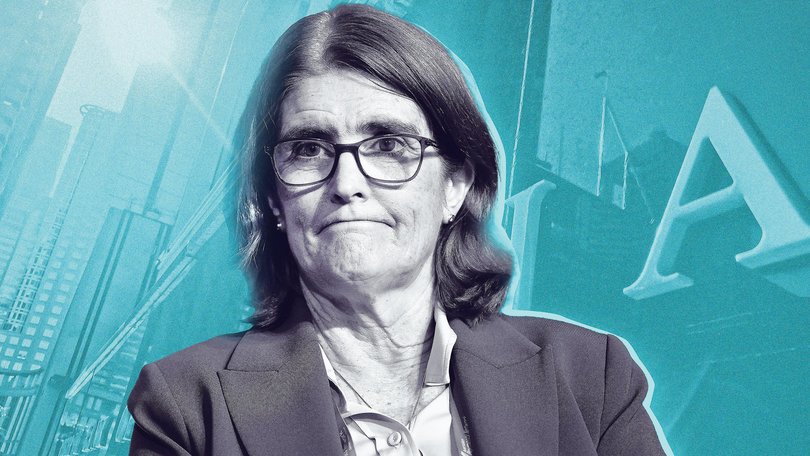Economists say the RBA has been too timid on rate cuts

The depressingly timid growth figures released this week has sent economists scurrying back to their models.
Just three weeks ago, the Reserve Bank was saying that it had effectively navigated the “narrow path” to a soft landing.
Its May meeting minutes reiterated a “preference to move cautiously and predictably” and said the Board had judged it was “not yet time to move monetary policy to an expansionary stance.”
Sign up to The Nightly's newsletters.
Get the first look at the digital newspaper, curated daily stories and breaking headlines delivered to your inbox.
By continuing you agree to our Terms and Privacy Policy.But with GDP rising just 0.2 per cent in the March quarter, and only 1.3 per cent annually, that narrow path looks more like a quagmire.
AMP deputy chief economist Diana Mousina, says the weak national accounts data has prompted AMP to forecast another four cuts — starting in July and stretching into early 2026.

“The most interesting part of the May meeting minutes was the discussion about whether to cut by 0.25 or 0.5 percentage points,” Ms Mousina said. “Ultimately, the board decided 50 basis points was too large given that domestic data was holding up. But now, with the GDP data softening further, another cut in July is likely.”
Ms Mousina points to a disturbing trend beneath the headline numbers: “Per capita GDP has fallen in 9 of the last 11 quarters — the longest decline on record. That’s bad for living standards. And productivity looks shocking. It’s down 0.9 per cent over the year, with the five-year rolling average now flat.”
Stephen Koukoulas, a former economist at Citibank and former economic adviser to Julia Gillar,, says the RBA should have acted sooner, and gone harder.
“They over-hiked in 2023, were too slow to cut in 2024, and they’re too slow to cut now,” he said. Mr Koukoulas argues that the current 3.85 per cent cash rate is well above neutral, and with the economy growing at just 1.3 per cent, the risk of a prolonged period of stagnation is rising.
“If we get another very weak result in the June quarter, we’re looking at a serious drag on the labour market,” he said.
Warren Hogan, economic adviser to Judo Bank, said the recent numbers mean the economy needs a shot in the arm.
He argued that weak productivity and collapsing business investment were signs the RBA’s current stance was still too tight.
“If businesses aren’t making money, they’re not investing. And that’s what we’re seeing,” Mr Hogan said.
One of the reasons the RBA has been so cautious has been the global turmoil caused by Donald Trump’s multilateral trade war.
In its minutes, the bank effectively has stated it wants to have ammunition in the event a global crisis. But Mr Hogan said it was time to focus on the domestic economy.
“They’ve said they want to get rates to neutral. Just do it. Be decisive. Show leadership,” he said.
“They’re talking about everything so uncertain. Well, that’s not what we need from them. We need them to lead the community on what’s happening. And just to say, ‘Oh, we don’t know,’ is not good enough.”
Westpac’s chief economist Luci Ellis, who previously headed the economics division at the RBA, also warned the risks to growth were tilted to the downside.
“As we have been highlighting for some time, underlying growth in Australia remains weak and sensitive to pauses in the expansion in the care economy,” she said.
“With inflation in the 2–3 per cent target range already, and likely to stay there, why wouldn’t the RBA cut further and faster than previously believed?”
Getting a grip on the labour market will be key.
Despite headline unemployment remaining around 4 per cent, economists argue the labour market may not be as tight as it appears. Mr Koukoulas said much of the resilience in jobs growth stemmed from government-funded sectors such as aged care, education, and disability services — areas less sensitive to interest rates.
“Maybe that government employment has masked weakness in the labour market,” he said.
Mr Hogan worried that the government was now determining the allocation of labour across the economy and undermining productivity because marginal labour — the next person hired — was no longer going to the most efficient or economically productive part of the economy.
“Seventy-five per cent of the new jobs are basically government mandated,” he said.
“We completely turned the public to private composition of new hiring on its head. That has kept wages up while pushing productivity down, which means unit labour costs are up.”
With the consumers still feeling the pinch, business has not been able to pass those costs on.
“The reason business investment is slowed is because profits have slowed, and with no visibility that profits will improve, because there’s no sign business costs are coming off, businesses aren’t investing,” he said.
That’s why Mr Hogan is calling for a sharp 0.35 per cent rate cut to 3.5 per cent at the next meeting.
Ms Ellis wonders the neutral rate might be even lower.
She noted that between November 2024 and February 2025, the RBA introduced new models of the neutral rate based on research from the New York Federal Reserve, which placed Australia’s neutral nominal rate in the high 2s, down from the low-to-mid 3s in earlier estimates.
That might give the RBA more room to move, but Ms Ellis is cautious on that point.
Either way, expectations have shifted markedly for a rate cut next month, with an 80 per cent probability of a cut to take the rate to 3.6 per cent. According to the ASX’s RBA Rate Indicator, which tracks futures, the interest rate is expected to settle at 2.91 per cent by May next year.
While lower rates would ease pressure on households and business, they also risk reigniting the housing market. AMP expects prices to rise by 5 to 6 per cent this year — a reminder that every rate cut comes with trade-offs.

